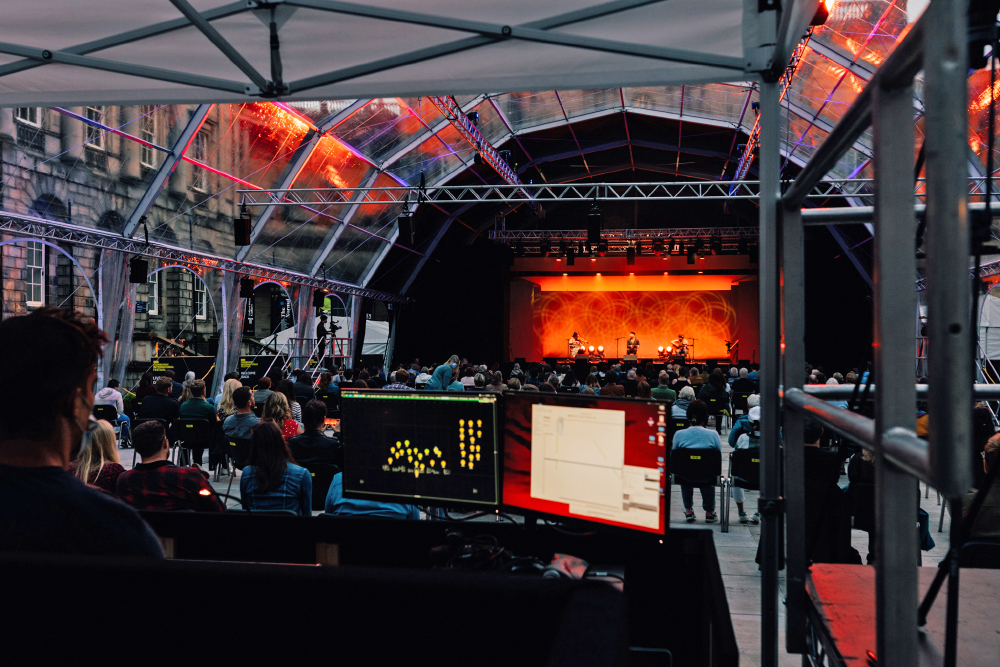Restrictions due to the pandemic at this year’s iteration of the long-established Edinburgh International Festival in Scotland saw the deployement of d&b Soundscape to help unite the disparate worlds of classical music and sound reinforcement in support of numerous performances.
On the grounds of Edinburgh’s Junior Academy and the city’s Old College Quad, two custom-built pavilions, each 100-meters long, were installed like giant bubbles, roofed, but open sided for free-flowing fresh air. To provide the critical aspect of audio initiated an exploratory chat with design consultants Sound Intermedia about ensuring that the sound reinforcement would be imperceptible to the many discerning ears who would be in attendance.
“At Sound Intermedia we’ve been embedded in the cultural world of classical artists and music for more than 20 years,” says founder Ian Dearden, “serving as a bridge, or translator, between the art and the technology. A PA often brings an element of anxiety to classical musicians. Of course, we’re always thinking about the audience experience, but you’re three quarters of the way there if you have performers who are comfortable and feel supported. And this year’s artists needed to feel at home playing in a tent.
“The tempo of the International Festival operation also meant constant changes,” he continues, “involving over 50 ensembles and soloists across two venues, with repertoire ranging from orchestral, opera, and musical revue, to chamber, folk and spoken word — almost all of whom are accustomed to performing in the natural acoustics of spaces like Usher Hall.”
Early on Soundscape piqued the interest of Dearden and his colleague at Sound Intermedia, David Sheppard. “We’re forever watchful of who’s doing interesting stuff and have been following Soundscape’s development; we knew for this year’s festival it was the enablement tool we needed, especially the virtual acoustic shell,” Dearden explains. “We took on a downstream-upstream approach to the project. David worked with d&b application support specialist Adam Hockley and the technical providers.

“Together they addressed the delivery of audio to the audience and performers. It was my job to coordinate with the artists, orchestras, broadcasters, and recording companies, to put together a plan to capture and share audio from the stages. It was a huge challenge, but one that everyone became really excited about.”
Hockley set to work designing and building the Soundscape system in ArrayCalc, d&b’s proprietary simulation software. “The festival organizers were incredibly trusting, essentially handing everything over to us,” says Hockley. “We had CAD drawings of the proposed canopy structures, so we knew what we were dealing with in terms of scale and space. As for the audience experience, the goal was to recreate the ambience of the concert hall to preserve the traditions on which classical music thrives.”
With similar pavilions at the quad and academy, Hockley’s system design concept was applied to both venues. The product infrastructure was installed and supported by local d&b partner FE Live, delivering the two Soundscape systems, in addition to a d&b KSL rig on the Park Stag in an extremely tight turnaround time. Due to FE Live’s attention to detail, the sound designers were able to get to work without delay, resulting in a speedy commissioning process.
A 180-degree source orientated design using En-Scene was employed to effectively sync sounds to their source – a voice to the person singing, for example – uniting the ears and eyes for a more intuitive listening experience. Meanwhile, En-Space enabled the virtual acoustic shell; with a 360-degree configuration for surround, plus loudspeakers in the ceiling, the acoustic signature of a concert hall, became the reality effect for the audience.
“Generally speaking, the acoustic properties of a concert hall are essential for the natural amplification of acoustic and orchestral music,” Hockley explains. “So, what we’re really doing is asking audiences to suspend their disbelief. Not only to believe they’re sat inside a concert hall, but to experience music acoustically, as if it were unamplified from distances far greater than is typical in such venues. In this way Edinburgh has really demonstrated the power and the subtlety of the Soundscape toolkit.”
Edinburgh International Festival head of sound Tom Zwitserlood states, “Almost daily after a concert, Jonathan Green and Tim Hand received praise, thumbs up and compliments from departing audience members. On one occasion I witnessed two older chaps, who I would describe as experienced classical music purists, giving Tim an absolute raving review about how brilliant it sounded: ‘the best and most natural sounding amplified performance ever’. The press has also mentioned the clarity and subtlety of it all in several concert reviews.
“d&b offers a lot of clarity, especially in the vocal range, which effects a lot of the shows we do,” he concludes. “We’ve always found the brand a safe bet because it appears on so many artists’ riders. I know if I put d&b in front of them it’ll be something they are very comfortable with, they know it stands for quality. It makes their life easy, and stress free for the engineers, and that makes for a happy festival visitor.”




















